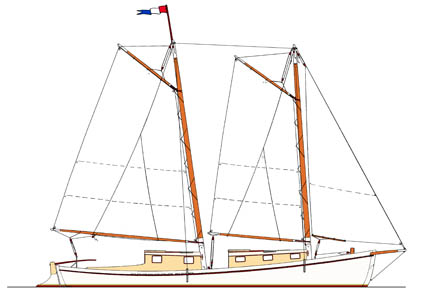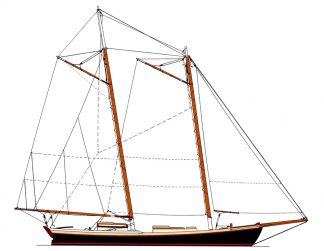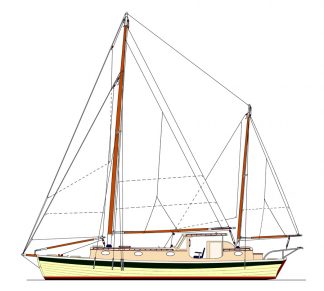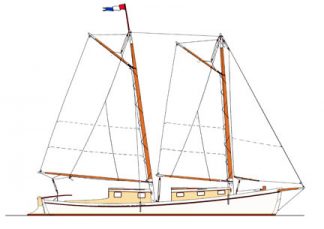Description
L.O.A. 52’ 0”
L.B.P. 45’ 0”
L.W.L. 43’ 7”
Beam 10’
Draft 2’ 6” / 7’ 8” (board up/board down)
Rig Bald-headed gaff schooner, self-tending
Sail Area 753 sq ft
Weight 15,000 lbs
Ballast 4,000 lbs lead in keel, hull & centerboard; 2,000 lbs water
Trailer Weight 12,000 lbs [40’ 3-axle trailer]
Bridge Clearance 36’/10’ masts down
This is a large version of the San Juan Islands sharpie, based on the 1880’s Washington State halibut fishermen. As background for the boat presented here, I used the model from Chapelle’s American Small Sailing Craft (which can also be seen in Chapter One, Fig. 1-19 of The Sharpie Book). I have here tried to create a contemporary cruising sharpie that retains the character and sea-keeping abilities of the original, which was intended for some rough-water sailing. I have altered the model to be proportionately lighter and narrower.
One of the most common requirements of cruising sailboats is that they have interior standing headroom—a feature not possible in small sharpies. Hence I have designed this cruising sharpie to achieve two goals: standing headroom (5’ 10”) and trailerability without escort vehicles. Hence the beam is limited to ten feet, and some of the ballast is supplied by huge fresh water tanks placed in the lowest and most central part of the hull.
The freeboard has been raised slightly (proportionately from the fishing boat model), the run has been flattened slightly, and a hollow box keel has been added to provide a place for external ballast, housing and protection for an inboard engine’s shaft log and transmission, a wet sump for the engine compartment, and to provide better tracking ability under sail and power. Oh, I almost forgot the wine cellar!
The cruiser sleeps four in a vee-berth and (private cabin) double berth forward. There is a small cargo hold (33 cubic feet) amidships on the port side. There are four water-tight bulkheads, making this vessel as close to unsinkable as possible.
I have designed modern foil-shaped rudder and centerboard based on a long evolution of shoal-draft components. The rudder is counterbalanced and has a foil-shaped endplate on the bottom. The centerboard is fabricated with a solid framework from PT pine and marine plywood, and is partially ballasted. In the down position, it is essentially a high-aspect-ratio fin keel. It is raised by an electric ATV winch, which is also used to raise and lower the tabernacled masts.
The rig provided is the gaff-schooner, with all sails self-tending. I chose this rig because it makes an excellent cruising rig for an extreme shoal-draft hull; because it performs very well off the wind (the sharpie’s best point of sail); and because of its utter simplicity (I have employed single halyards instead of peak and throat halyards seen on larger gaff sails). There are battens located at each deep reef point, making reefing simple and easy as well as providing good sail shape. The original fishermen were also gaff schooners. The masts are shown in tabernacles for convenience in trailering as well as allowing the boat to run under low bridges. With masts down, the boat could pass under 90% of the ICW bridges without having to wait for openings, saving as many as several days on a cruise of the US East Coast.
The diesel auxiliary is located under a lowered cockpit bridge deck, as with many of my designs. I feel this is an ideal location, and because of the sharpie’s long cockpit and the addition of a box keel, this boat does not require the usual Hurth Vee-drive. I recommend 35 to 45 horsepower, which should move the light, flat-bottom hull very nicely in calm conditions, providing almost motorsailer capabilities. The compact Yanmar 3LD40 would be a good motor for this boat, consuming about .75 gallons per hour @ a continuous 2,800 rpm. A 3-blade feathering prop will be ideal because of the sharpie’s high speeds under sail.
The MAXI-TRAILERABLE concept will require a long custom-modified three-axle trailer. A large, powerful 4-wheel drive truck will be required to launch and haul the boat; or a travel-lift may be used in a local boatyard. The justification for the maxi-trailerable concept is the increasing cost and decreasing availability of slip space, and the gradual disappearance of boatyards in America. The concept is that the individual owner will be able to launch, haul, maintain and store a fairly large cruising sailboat without being victimized by high costs and limited availability of slips and services. Sharpies are ideal for this, and I now have designed five (4 sail, 1 power) maxi-trailerable models.
I lived and sailed on the prototype, IBIS, for several years, and made four trips to the Bahamas in her. This is an ideal island cruising boat!






Reviews
There are no reviews yet.